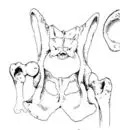Apparently, I have written about dislocated hips before, but I can't find my original post right now. I received an email on the subject from Ireland today. [These diagrams are lifted from Brinker, Piermatti & Flo (orthopedic text).]
On Tue, 19 Jan 2010 20:18:56 -0000, Paddy from Wicklow, Ireland
wrote
 I have a 4 year old very intelligent
I have a 4 year old very intelligent
border collie
bitch.
She is a great sheepdog, but more important she
is
my best friend and companion after my wife. I want the best treatment for
her.
She was hit by a jeep wheel on the left
hindquarters on 12th December 2009. Our vet immediately gave painkilling
injections and supplied tablets for pain. I brought her back to him several
times and he said not to worry and kept giving painkiller
tablets.
I was not happy and I suspected a dislocated
hip.I
changed vets and the new vet x-rayed the hip yesterday 18th
Jan. The hip is dislocated and nothing else wrong.
She
is still mobile on 3 legs.
The vet said it was too long out to put back
and it
would be a big job. She recommended surgery to remove the femoral knob. I think
that is very drastic and extreme and also she has never done it before. She will
not try manipulation as I have asked
her.
Your article on hip dislocations has given me
hope
if only I could get a vet to do it. Under anesthetic it is at least worth a
try. We have a bonesetter in the next County. Would
you
think it advisable to let him see
her?
Doc Mobley replies:
Hello, Paddy,
If by "bonesetter" you mean a doctor (vet) who specializes in
orthopedics (fractures, dislocations, or other bone surgery), then yes,
I think that's a good idea.
 The longer that the hip stays out of socket, the less likely it is that
The longer that the hip stays out of socket, the less likely it is that
simply replacing it will be successful. The socket will have a bunch
of clot-like material filling it up. That could have been displaced if
the hip had been put back soon after the injury. Now it is more
organized, and probably won't just "push out of the way".
Also, the other structures that support the hip, the muscles and
ligaments will have shrunk or stretched to accommodate the new position
of the thigh-bone. This would have a tendency to pull the ball back
out of the socket.
 Removal of the femoral head (the "ball" in the ball and socket joint)
Removal of the femoral head (the "ball" in the ball and socket joint)
is not a terrible thing to do. There is enough muscle and tendon to
support the dog's weight in this area. Sometimes they will form a
"false joint", where the ball sort of "nests" in some other area. They
may get around fine. However, if there is bone-on-bone contact, this
causes pain. Removal of the femoral head relieves that pain.
To replace the hip joint back in socket and keep it there would (almost
certainly) require a good orthopedic surgeon who could stabilize the
joint with some type of implant (screws, wires, etc.)
Good luck in caring for your second-best friend.


I know this surgery does sound gruesome to clients, even to me, but they do do surprisingly well, don’t they.
I have always wondered what the “false joint” looks like and can’t remember if we have ever re-xrayed a pet say a year later to see what it looks like–I am sure we have, I just don’t remember what it looked like.
So, your second picture is a big help.
Our first dog was HBC and after the first vet I took her to did the same as Paddy’s vet, except without the painkilling drugs, I had the surgery done by someone else. She got around great (she ran and jumped and pulled like a lead sled dog) for 13 1/2 more years, she always walked just the tiniest bit sideways – like a unibody out of alignment. We, of course, thought this made her extra special.
I hope Paddy lets us know what happens!
i have a blue hearler that dilocated hip has been out for about 4week can i put it back in my self ? vet wanted 600.00 to just put back in
Hello, Inez,
Even when the injury is fresh and the patient is completely anesthetized, replacing the hip is a difficult process.
I do not believe it would be possible for even a skilled doctor to replace the hip in a conscious dog. The muscles spasm and stretching them to that extent would as painful as dislocating the hip in the first place.
Having had several shoulder dislocations, I can tell you that it is very painful indeed.
After four weeks, it is unlikely that the hip would stay in place without some surgery to hold it there.
If your dog does not form a “false joint” and learn to walk on the limb (50/50 chance), then your best bet will probably be surgery to remove the “ball” of the ball-and-socket. This stops the pain of bone-on-bone.
Sorry that I don’t have a simple answer for you.
An orthopedic surgery specialist would be your best bet, but that will run a lot more than $600, probably more like $2,000.